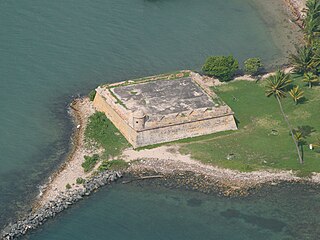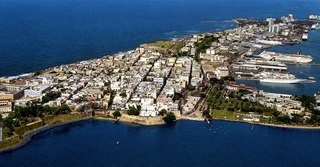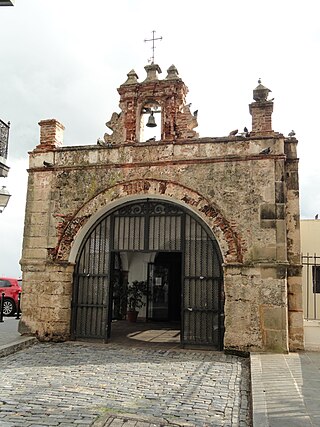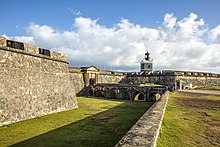
San Juan is the capital city and most populous municipality in the Commonwealth of Puerto Rico, an unincorporated territory of the United States. As of the 2020 census, it is the 57th-largest city under the jurisdiction of the United States, with a population of 342,259. San Juan was founded by Spanish colonists in 1521, who called it Ciudad de Puerto Rico.
Tourism in Puerto Rico attracts millions of visitors each year, with more than 5.1 million passengers arriving at the Luis Muñoz Marín International Airport in 2022, a 6.5% increase from 2021, the main point of arrival into the island of Puerto Rico. With a $8.9 billion revenue in 2022, tourism has been a very important source of revenue for Puerto Rico for a number of decades given its favorable warm climate, beach destinations and its diversity of natural wonders, cultural and historical sites, festivals, concerts and sporting events. As Puerto Rico is an unincorporated territory of the United States, U.S. citizens do not need a passport to enter Puerto Rico, and the ease of travel attracts many tourists from the mainland U.S. each year.

La Fortaleza, also known as the Palacio de Santa Catalina, is the official residence and workplace of the governor of Puerto Rico. Located in the historical district of Old San Juan in the capital municipality of San Juan, it has served as the governor’s residence since the 16th century, making it the oldest executive mansion in continuous use in the New World. Built from 1533 to 1540 by orders of King Charles I of Spain, the structure was the first fortification constructed by the Spanish on San Juan Islet to defend San Juan Bay, the harbor of Old San Juan. La fortaleza, alongside El Morro, San Cristóbal, El Cañuelo, and other forts part of the Walls of Old San Juan, protected strategically and militarily important Puerto Rico, or La Llave de las Indias, from invasion by competing world powers and harassment by privateers and pirates during the Age of Sail. It was designated a World Heritage Site in 1983.

Castillo San Felipe del Morro, most commonly known as El Morro(The Promontory), is a large fortress and citadel in the historic district of Old San Juan in Puerto Rico. Commissioned by King Charles I of Spain in 1539, it was first built as a fortified tower in honor of King Philip II, who oversaw its expansion into a hornwork fort by 1595. Over the next 200 years, especially in the reign of King Charles III, El Morro continued to be developed to reach its current form in 1787. Rising 140 ft from the Atlantic shoreline with 18 to 25 ft thick walls, the six-leveled edifice stands on a steep, rocky headland promontory on San Juan Islet guarding the entry to San Juan Bay, the harbor of Old San Juan. El Morro, alongside La Fortaleza, San Cristóbal, El Cañuelo, and other forts part of the Walls of Old San Juan, protected strategically and militarily important Puerto Rico, or La Llave de las Indias, from invasion by competing world powers during the Age of Sail. It was designated a World Heritage Site by UNESCO in 1983.

Castillo San Cristóbal is a fortress in the historic district of Old San Juan, Puerto Rico, known as the largest fortification built by the Spanish in the New World. Dating back to defense expansions following attacks by the English in 1598 and the Dutch in 1625, it was first built in 1634 as the Garita del Diablo and an artillery platform. Over the next 150 years, especially in the reign of King Charles III of Spain, it continued to be developed into a bastion fort to reach its largest size in 1790. Rising 150 ft from the Atlantic shoreline, the three-level edifice stands on a hill at the northern coastline of San Juan Islet, guarding the land entry to Old San Juan. San Cristóbal, alongside El Morro, La Fortaleza, and other forts part of the Walls of Old San Juan, protected strategically and militarily important Puerto Rico, or La Llave de las Indias , from invasion by competing world powers during the Age of Sail. It was designated a World Heritage Site by UNESCO in 1983.

Old San Juan is a historic district located at the "northwest triangle" of the islet of San Juan in San Juan. Its area roughly correlates to the Ballajá, Catedral, Marina, Mercado, San Cristóbal, and San Francisco sub-barrios (sub-districts) of barrio San Juan Antiguo in the municipality of San Juan, Puerto Rico.

San Juan National Historic Site in the Old San Juan section of San Juan, Puerto Rico, is a National Park Service-managed historic site which preserves and interprets the Spanish colonial-era fortification system of the city of San Juan, and features structures such as the San Felipe del Morro and San Cristóbal fortresses. This fortification system is the oldest European construction under United States jurisdiction and one of the oldest in the New World. This national historic site, together with La Fortaleza, have been designated a UNESCO World Heritage Site since 1983.

Fortín San Juan de la Cruz, most commonly known as El Cañuelo, was built on Isla de Cabras in the Palo Seco barrio of the municipality of Toa Baja, at the western end of the entrance to San Juan Bay, in Puerto Rico. The square coastal fort has massive sandstone walls that date back to the 1630s. Although the U.S. Navy bombarded the fort in 1898, the fort survived. Today the fort is part of the San Juan National Historic Site, which is listed as a UNESCO World Heritage Site and on both the National Register of Historic Places and the Puerto Rico Register of Historic Sites and Zones. The fort is not open to visitors, but it can be viewed from its exterior.

San Antonio Missions National Historical Park is a National Historical Park and part of a UNESCO World Heritage Site preserving four of the five Spanish frontier missions in San Antonio, Texas, US. These outposts were established by Catholic religious orders to spread Christianity among the local natives. These missions formed part of a colonization system that stretched across the Spanish Southwest in the 17th, 18th, and 19th centuries.

San Juan Islet is a 3-square-mile (7.8 km2) islet or small island on San Juan Bay in the Atlantic coast of northern Puerto Rico. Home to Old San Juan, it is the site of the oldest permanent European settlement in Puerto Rico (1521), and the second oldest European settlement in the West Indies after Santo Domingo (1496). Due to its strategic location in the Caribbean during the Spanish colonization of the Americas, it is home to a city wall and a number of militaristic buildings such as El Morro Castle. Today, it is also home to many of Puerto Rico's government buildings such as the territory's capitol building.

The culture of Puerto Rico is the result of a number of internal and indigenous influences, both past and present. Modern cultural manifestations showcase the island's rish history and help create an identity that is uniquely Puerto Rican - Taíno, Spanish, African, and North American.

The Caguana Ceremonial Ball Courts Site is an archaeological site located in Caguana, Utuado in Puerto Rico, considered to be one of the largest and most important Pre-Columbian sites in the West Indies. The site is known for its well-preserved ceremonial ball courts and petroglyph-carved monoliths. Studies estimate the in-situ courts to be over 700 years old, built by the Taíno around 1270 AD.

The Supreme Court Building in San Juan, Puerto Rico is an architecturally significant Modern-style building and the seat of the Supreme Court of Puerto Rico. It was built in 1955 and listed on the U.S. National Register of Historic Places in 2006. Its modern architecture reflects changes to the Court after the establishment of Puerto Rico's new Commonwealth Status in 1952. The main façade is oriented toward the sites of the other two government's branches: the Capitol and La Fortaleza.
The following is a timeline of the history of the municipality of San Juan, Puerto Rico.

Capilla del Cristo, also called Capilla del Santo Cristo de la Salud is a small chapel / museum located in the Old San Juan, Puerto Rico. Built in the 18th century and saved from demolition in the 20th century and preserved, the structure has become a cultural icon of Puerto Rico. Most of the articles located at its altar are from 1753. Travel guides list Capilla del Cristo as one of the must-see places of Old San Juan.

Paseo de la Princesa, is a partially waterside 19th-century pedestrian promenade about .50 miles (0.80 km) in length, located in the historic district of Old San Juan in Puerto Rico. Constructed between 1852 and 1854 in honor of Queen Isabella II of Spain’s first-born, Princess of Asturias Infanta Isabel, the promenade runs adjacent and parallel to the southwestern section of the Walls of Old San Juan. Lined with Victorian lampposts and benches, large trees and gardens, and varying fountains and sculptures, it hosts food and artisan vendors, musical and theatrical entertainers, and cultural restaurants and festivals.

The Advanced Defense Line is a historic district consisting of four structures that formed part of the eastern defensive system of the Islet of San Juan in San Juan, Puerto Rico.

The Walls of Old San Juan is a defensive city wall that surrounds the western end of the San Juan Islet, site of the historic district of San Juan, Puerto Rico. This defensive wall system was built between the 16th and 18th centuries to protect the city and the Bay of San Juan, a highly strategic point in the Caribbean. These walls, along with the defensive fortresses in Old San Juan, form part of the UNESCO World Heritage Site-designated San Juan National Historic Site as they are characteristic examples of the historic methods of construction used in military architecture which adapted European designs and techniques to the special conditions of the Caribbean port cities.

















